
94% of researchers rate our articles as excellent or good
Learn more about the work of our research integrity team to safeguard the quality of each article we publish.
Find out more
BRIEF RESEARCH REPORT article
Front. Public Health , 15 June 2021
Sec. Occupational Health and Safety
Volume 9 - 2021 | https://doi.org/10.3389/fpubh.2021.664013
This study aimed to analyze the bibliometric characteristics of the publications on occupational stress and highlight key research topics and future trends. The Web of Science Core Collection database was searched to collect publications on occupational stress, from inception to December 9, 2020. Two authors independently screened eligible literature and extracted the data. Bibliometric analyses were performed using VOSviewer 1.6.6 and R 3.6.3 software. Overall, 6,564 publications on occupational stress were included. “Stress,” with a total link strength of 1,252, appeared as the most co-occurrence keyword, followed by “occupational stress,” “job stress,” and “job satisfaction.” All studies were published between 1956 and 2020. Among them, 6,176 (94.35%) papers were written in English, and 4,706 (70.25%) were original articles. The top three Web of Science categories were “public environmental occupational health” (n = 1,711), “psychology, applied” (n = 846), and “psychology, multidisciplinary” (n = 650). The 100 top-cited articles were mentioned a total of 36,145 times, with a median of 361, ranging from 174 to 5,574. The United States was the most productive country, with 1,780 publications. The main partners of the United States were England and China. Three themes of occupational stress research were identified: job satisfaction, burnout, and occupational stress-related health problems. This bibliometric analysis provides a comprehensive understanding of the trends and most influential contributions to the field of occupational stress, thus promoting ideas for future research.
Occupational stress is the process by which workplace psychological experiences and demands (stressors) produce both short- and long-term changes (strains) in mental and physical health (1). The annual National Health Service (NHS) staff survey conducted in England showed that approximately 30% of workers suffer from occupational stress (2). Moreover, a meta-analysis found that the overall prevalence of occupational stress among nurses working in Iranian hospitals was 60% (3). Occupational stress is associated with many diseases (1), such as cardiovascular diseases (4, 5), depression (6), and type 2 diabetes (7). Occupational stress is also closely related to insomnia (8), alcoholism (9), smoking (10), and unhealthy weight fluctuations (11), which further affect physical and mental health.
Recently, increasing research has focused on occupational stress. Bibliometric analysis can detect critical junctures in the development of research fields, especially intellectual turning points and pivotal moments (12). Moreover, it can provide insights regarding prominent areas of interest, with an emphasis on the countries, institutions, journals, and authors with the greatest global impact. The scientific knowledge graph is a new domain in the development of bibliometric analysis, which can visually represent research results (13, 14). Another crucial component of bibliometric analysis is citation analysis, which provides comprehensive information regarding cited articles (15). Bibliometric analysis has been applied in various disciplines, such as neuropsychology (16), cancer (17), respiratory medicine (18), COVID-19 (19), and vaccines (20).
However, no bibliometric analysis of publications has been conducted on occupational stress. Since occupational stress has become an important area of occupational health, and increasing research has been published on the topic, it is imperative to conduct a bibliometric analysis in this area. Therefore, in the present study, we aimed to provide a broad understanding of occupational stress and to highlight the key research topics, thus promoting ideas for future studies.
The Web of Science Core Collection database was searched for publications on occupational stress from inception to December 9, 2020. The search strategies were as follows: [occupational OR job OR job-related OR (job related) OR work-related OR (work related) OR workplace OR (work place) OR professional] AND (stress* OR strain*) in the title. The language and literature types were not limited during the process of retrieval. Literatures were excluded on several criteria. First, the title of these literatures had the above-mentioned keywords; however, the content of the literature was about heat stress, muscle strain, oxidative stress, stress fracture, postural stresses, non-work-related posttraumatic stress, work-related physical stress, occupational ergonomics, and mechanical stress in the workplace or occupational groups. In this occupational stress literature bibliometric analysis, environmental stressors refer to psychosocial stressors. Second, literatures were excluded when psychological stress was not work related or occurring in nonworking people, such as students or full-time mothers. Finally, items were excluded when strain referred to a microorganism in the workplace. Two authors independently screened titles, abstracts, and full texts for eligible literature. Disagreements were resolved through discussion or by a third reviewer.
Information including the title, publication year, language, author, journal name, affiliation, keywords, document type, Web of Science category, abstract, and total number of citations were identified and recorded by two authors. The results were compared, and disagreements were resolved through discussion or by a third reviewer.
We used VOSviewer software (version 1.6.6) to analyze the co-authorship, co-occurrence, co-citation, citation, themes, and topics. We also used R software (version 3.6.3) to perform correlation analysis, which was used to evaluate the relationships between the different terms. A p-value of ≤ 0.05 (two-tailed) was considered statistically significant.
We identified 7,106 potentially relevant literatures. After screening the titles, abstracts, and full texts, 6,546 publications on the topic of occupational stress were included. The literatures were published between 1956 and 2020 (Figure 1). Among them, 6,176 (94.35%) studies were written in English, followed by German (145; 2.22%) and Spanish (50; 0.76%). Of the published papers, 4,706 (70.25%) were original articles, followed by meeting abstracts (11.29%), proceedings papers (6.84%), reviews (2.81%), book reviews (2.60%), and other forms of publications (6.22%) including editorial material, letters, notes, and so forth. The included publications were divided into different Web of Science categories. The top three Web of Science categories were: “public environmental occupational health” (n = 1 711); “psychology, applied” (n = 846); and “psychology, multidisciplinary” (n = 650).
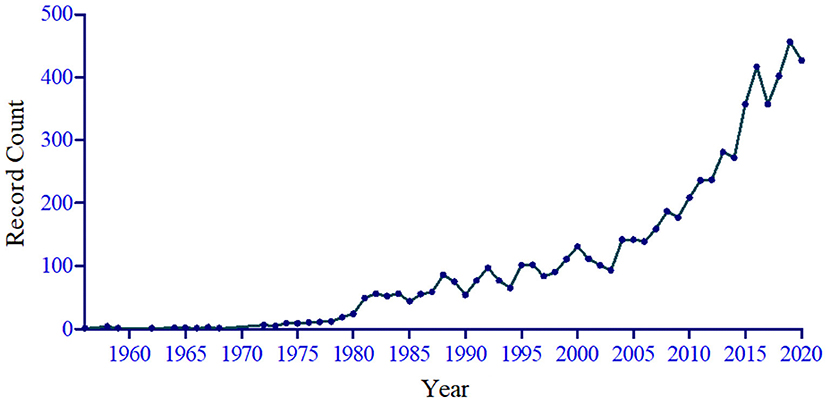
Figure 1. Number of publications issued per year in the occupational stress field from 1956 to 2020.
The top 10 most published journals, countries, organizations, and authors for occupational stress are shown in Figure 2. In total, 1,003 (14.82%) papers were published in the top 10 active journals. The International Journal of Psychology had the most publications, with an impact factor of 1.255 in 2019. Work and Stress ranked second, with an impact factor of 3.512, and ranked in Q1 for the psychology applied category in 2019. A total of 5,618 institutions from 125 countries contributed to the publications on occupational stress. The most productive author was Cooper CL from the University of Manchester, with 91 related papers.
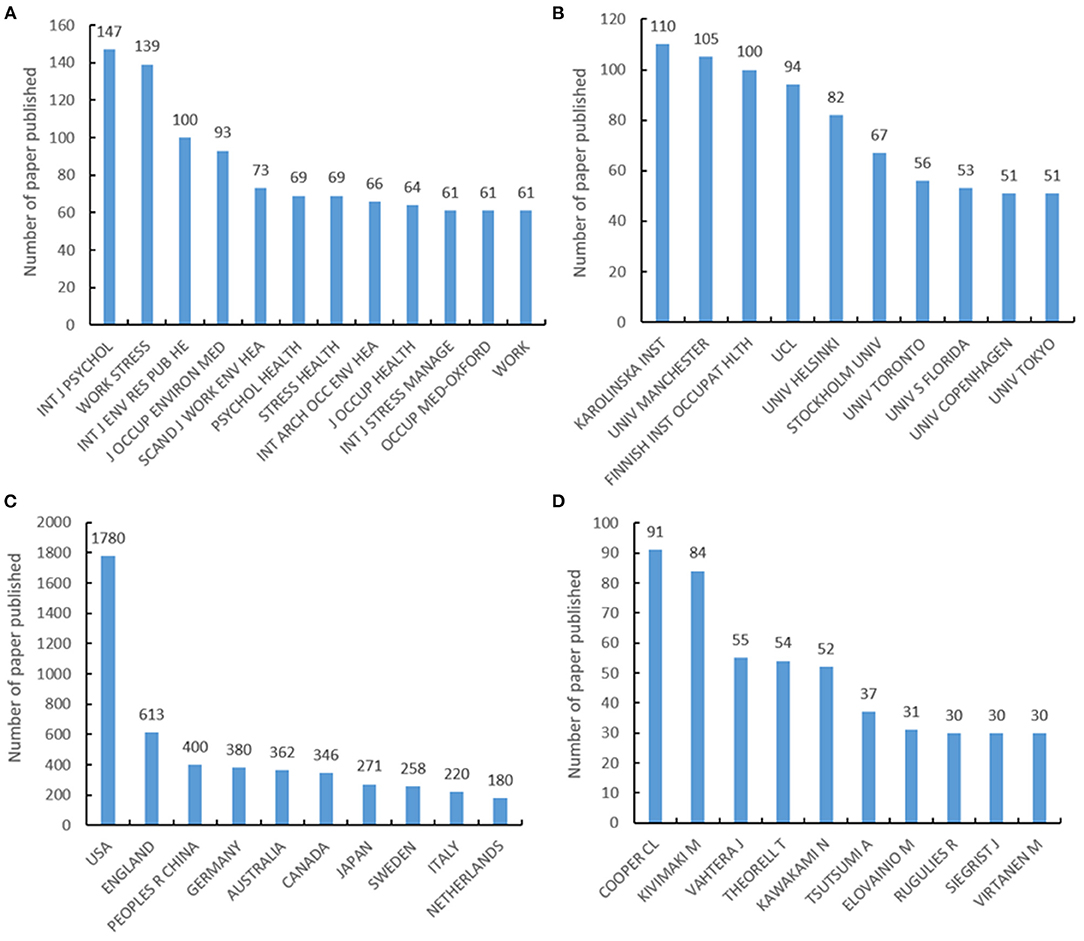
Figure 2. The top 10 most published journals, organizations, countries, and authors of occupational stress publications. (A) The top 10 most published journals of occupational stress publications. (B) The top 10 most published organizations of occupational stress publications. (C) The top 10 most published countries of occupational stress publications. (D) The top 10 most published authors of occupational stress publications.
Keywords occurring over 10 times in the database were included in the analysis. Of the 6,818 keywords, 222 met the threshold. “Stress” (with a total link strength of 1 252) appeared as the most co-occurring keyword, followed by “occupational stress,” “job stress,” and “job satisfaction” (Figure 3).
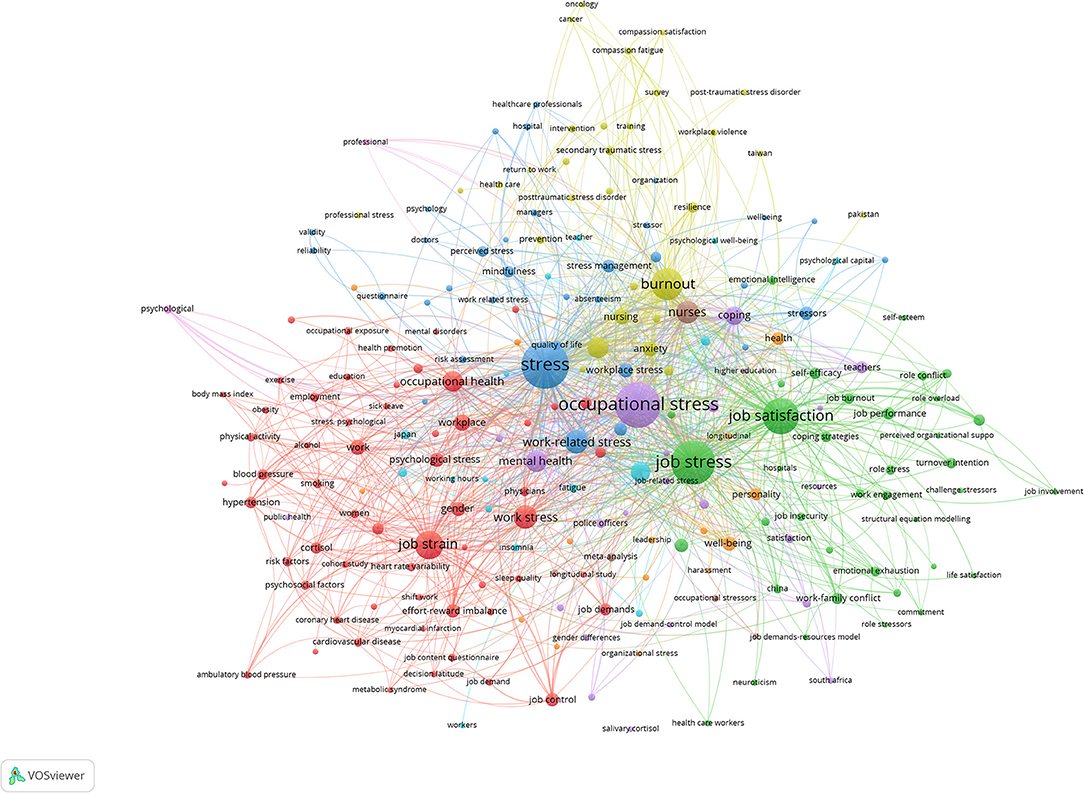
Figure 3. Bibliometric analysis of co-occurrence of keywords in publications of occupational stress. The size of nodes indicates the frequency of occurrence. The curves between the nodes represents their co-occurrence in the same publication. The shorter the distance between two nodes, the larger the number of co-occurrence of the two keywords.
The Supplementary Material shows the 100 top-cited papers in the field of occupational stress. The 100 top-cited papers were cited 36,145 times in total, ranging from 174 to 5,574, with a median of 361. The average number of citations per year ranged from 3 to 136, with a median of 18 mentions for the 100 top-cited papers. The total number of citations of the 100 top-cited papers were correlated with the annual mean citations (r = 0.791, p < 0.001). Of the 100 top-cited publications, 93 were original articles, and seven were reviews (Table 1). There were 13 countries that contributed to the 100 top-cited studies. The United States was the most productive country, with the highest average citation. The 100 top-cited studies were published between 1958 and 2015. The most top-cited articles were published in the year 2000 (n = 8), followed by 1998 (n = 7) and 2001 (n = 7). The Journal of Applied Psychology had the highest number of publications (n = 11), followed by the Journal of Organizational Behavior (n = 8), the Scandinavian Journal of Work Environment & Health (n = 5), and the Academy of Management Journal (n = 5).
The co-authorship maps of organizations and countries are shown in Figure 4. The Karolinska Institutet published 110 papers. A major partner of the organization was the Stockholm University. The most productive country was the United States with 1,780 publications. Major partners of the United States were England and China.
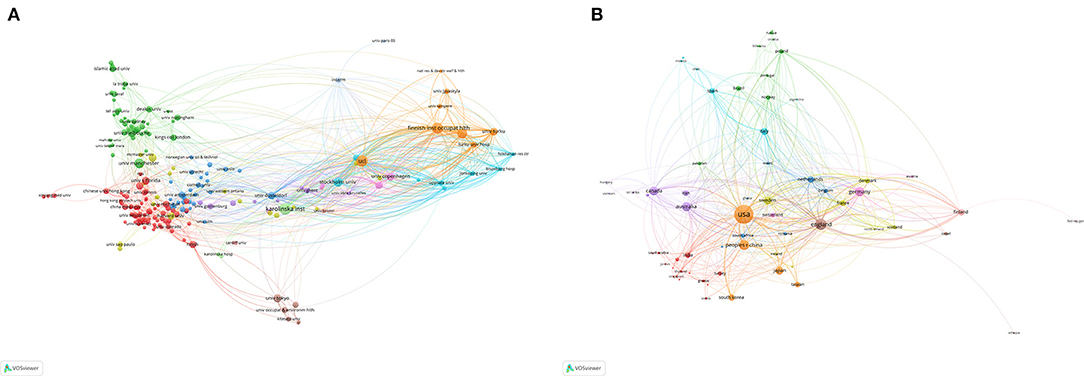
Figure 4. Bibliometric analysis of co-authorship. (A) Co-authorship map of organizations. (B) Co-authorship map of countries. Different colors indicate different clusters, and the size of circles indicate the number of publications. The thickness of the lines represents the link strength of the organizations or countries.
References with over 40 citations in the database were included in the analysis. Of the 121,510 cited references, 197 met the threshold. Four clusters of the cited references were obtained via bibliometric analysis. The most co-cited reference was Karasek RA (1979), with a total link strength of 5,015 and 875 citations (Figure 5A). Sources with over 60 citations in the database were also enrolled into analysis. Of the 38,928 sources, 459 met the threshold. Four clusters of the cited sources were obtained via bibliometric analysis. The Journal of Applied Psychology, Work and Stress, and the Journal of Organizational Behavior ranked in the top three, with 5,760, 2,749, and 2,159 citations, respectively (Figure 5B).

Figure 5. Bibliometric analysis of co-citation. (A) Co-citation of the documents. (B) Co-citation of the sources. The size of the circles represents the counts of co-citations. The distance between the two circles indicates their correlation.
Terms from the title and abstract fields were extracted. Three themes of occupational stress research were identified: job satisfaction, burnout, and occupational stress-related health problems. Indicators display the current publications from purple to yellow. More researches focusing on stress-related health problems and stress intervention have been published recently (Figure 6).
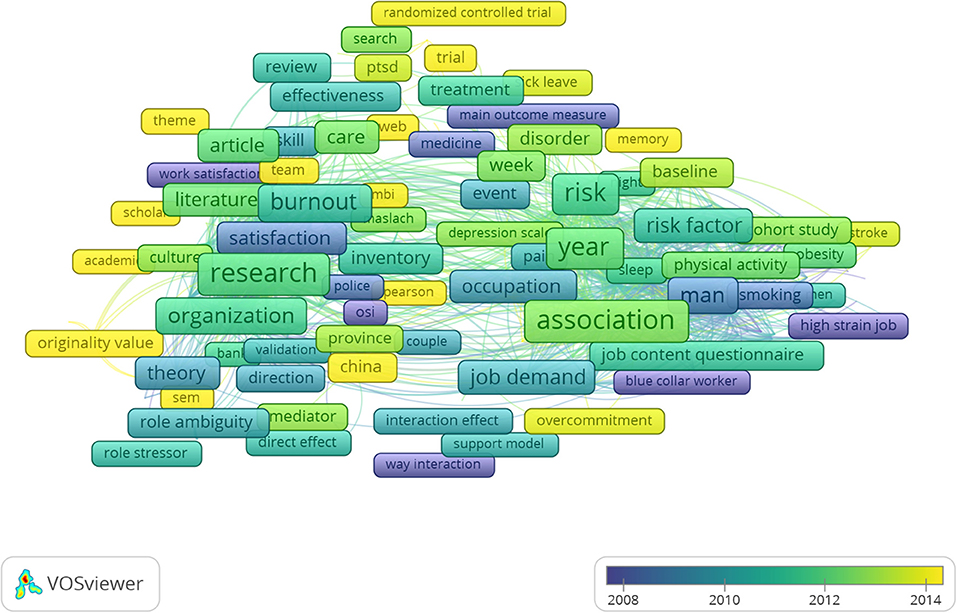
Figure 6. A term co-occurrence map according to terms from the title and abstract fields. Indicators show the current publications from purple to yellow. The size of the frames represents the frequency of appearance as the keywords. The distance between the two frames indicates their correlation. The closer the distance, the more similar the theme.
Bibliometric analysis has been firmly established as a scientific specialty and is an integral component of research evaluation methodology, especially within the scientific and applied fields (21). With the proliferation of medical information, bibliometric analysis has been used to examine various health research domains (22). However, no bibliometric analyses have been conducted among publications on occupational stress. Therefore, this study aimed to provide a comprehensive analysis of published literature in the field of occupational stress.
In this study, we found that the number of literatures published on occupational stress have increased between 1956 and 2020. Occupational stress drastically increased during COVID-19 pandemic, requiring comfort rules for healthcare workers after use of protective device to improve work performance reduction, difficulty in concentrating, and sleep disorders (23). People have begun to emphasize mental health and have realized that occupational stress adversely affects both work performance and overall health (1, 24). Therefore, researchers have increasingly focused on occupational stress. “Stress” appeared as the most co-occurring keyword, followed by “occupational stress,” “job stress,” and “job satisfaction.” Studies concentrated on the following aspects: the theoretical model of occupational stress (1), the stress levels of different occupational groups (25, 26), the relationship between occupational stress and job satisfaction (27), the relationship between occupational stress and disease (1), biomarkers of occupational stress (28), and the relationship between occupational stress and behavioral changes (9). Occupational stress is an interdisciplinary science of public health and psychology. Thus, the top three Web of Science categories were: “public environmental occupational health,” “psychology, applied,” and “psychology, multidisciplinary.”
The most frequently cited article received 5,574 citations and was published in 1979 (29). The major findings of the study indicated that redesigning work processes to allow a greater decision latitude for a broad range of workers could reduce mental strain. This can be achieved without affecting the job demands associated with organizational output levels. The results of the study were widely utilized in subsequent research. Combined with the passage of time, the study had the highest frequency of citations. Meanwhile, the study (29) appeared as the most co-cited reference.
The 100 top-cited studies were not recent, having been published between 1958 and 2015. Similar findings were reported in previous studies (16, 20). It is difficult to obtain high total citations for newly published articles due to the short duration of their availability. Among the 100 top-cited articles, the Journal of Applied Psychology had the highest number of publications, followed by the Journal of Organizational Behavior. These are two classic journals in the applied psychology field, ranking in the top 10%. While studies on occupational stress have been conducted worldwide, developed countries perform better than developing countries in this research area. The United States was the most productive country with highest average citation. The pronounced influence of the United States may be attributed to its large number of scientific research institutions and abundant research funds. They pay attention to occupational stress earlier and mental health. Major partners of the United States were England and China. Although China ranked third among the most-productive countries, it did not appear among the 100 top-cited articles. This phenomenon indicates that developing countries may disregard occupational stress in favor of devoting more energy to solving physical health problems.
Three themes of occupational stress research were identified: job satisfaction, burnout, and occupational stress-related health problems. Presently, most studies have a cross-sectional design, and few longitudinal studies or pilot trials have been conducted to evaluate health effects and interventions (30, 31). In addition, occupational stress measurement tools are diverse, and the results are difficult to compare. Therefore, more high-quality studies with improved designs focusing on the measurement of occupational stress are needed in the future. More research focusing on stress-related health problems and stress intervention has been published recently. The long-term health effects of occupational stress require more well-designed cohort studies to verify. Furthermore, field intervention trials are needed to evaluate the effects of different occupational stress interventions.
There are some limitations to this study. First, we may have missed literatures that did not contain the keywords in the title. Second, only the Web of Science database was searched for analyses, and we did not collect data from other databases such as Embase, Medline, Scopus, and Google Scholar. Third, the number of citations of each publication will change over time; subsequently, the 100 top-cited articles will also change. Thus, our research is only representative of the current research context. In future studies, we will include more databases in the analyses and dynamically track the changes in this field. Despite these limitations, we believe that as the first bibliometric analysis of occupational stress, our findings make a significant contribution to understanding the trends and influential publications in this domain.
In conclusion, this study analyzed the publications on occupational stress according to the authors, journal, publication year, country, institution, and study type. Moreover, this study provides insight into the 100 top-cited publications in occupational stress research. This bibliometric analysis offers a more comprehensive understanding of trends and the most influential contributions to the field of occupational stress, thus promoting ideas for future research.
The original contributions presented in the study are included in the article/Supplementary Material, further inquiries can be directed to the corresponding authors.
YoZ and YaZ designed the study. YaZ and LH analyzed the data. YaZ drafted the manuscript. LH, YW, YL, and YoZ edited the manuscript. All authors contributed to the article and approved the submitted version.
This study was supported by the National Nature Science Foundation of China (No. 82073521).
The authors declare that the research was conducted in the absence of any commercial or financial relationships that could be construed as a potential conflict of interest.
We would like to thank Editage for English language editing.
The Supplementary Material for this article can be found online at: https://www.frontiersin.org/articles/10.3389/fpubh.2021.664013/full#supplementary-material
1. Ganster DC, Rosen CC. Work stress and employee health: a multidisciplinary review. J Manag. (2013) 39:1085–22. doi: 10.1177/0149206313475815
2. Preece R. Work-related stress: case definitions, prevalence and the NHS national surveys. Occup Med. (2011) 61:136. doi: 10.1093/occmed/kqq200
3. Mohammadi M, Vaisi-Raygani A, Jalali R, Salari N. Prevalence of job stress in nurses working in Iranian hospitals: a systematic review, meta-analysis and meta-regression study. J Health Safety Work. (2020) 10:11–4.
4. Kivimaki M, Nyberg ST, Batty GD, Fransson EI, Heikkila K, Alfredsson L, et al. Job strain as a risk factor for coronary heart disease: a collaborative meta-analysis of individual participant data. Lancet. (2012) 380:1491–7. doi: 10.1016/S0140-6736(12)60994-5
5. Belkic KL, Landsbergis PA, Schnall PL, Baker D. Is job strain a major source of cardiovascular disease risk? Scand J Work Environ Health. (2004) 30:85–128. doi: 10.5271/sjweh.769
6. Iacovides A, Fountoulakis KN, Kaprinis S, Kaprinis G. The relationship between job stress, burnout and clinical depression. J Affect Disord. (2003) 75:209–21. doi: 10.1016/S0165-0327(02)00101-5
7. Nyberg ST, Fransson EI, Heikkila K, Ahola K, Alfredsson L, Bjorner JB, et al. Job strain as a risk factor for type 2 diabetes: a pooled analysis of 124,808 men and women. Diab Care. (2014) 37:2268–75. doi: 10.2337/dc13-2936
8. Yang B, Wang Y, Cui F, Huang T, Sheng P, Shi T, et al. Association between insomnia and job stress: a meta-analysis. Sleep Breath. (2018) 22:1221–31. doi: 10.1007/s11325-018-1682-y
9. Heikkila K, Nyberg ST, Fransson EI, Alfredsson L, De Bacquer D, Bjorner JB, et al. Job strain and alcohol intake: a collaborative meta-analysis of individual-participant data from 140 000 men and women. PLoS ONE. (2012) 7:e40101. doi: 10.1371/journal.pone.0040101
10. Ayyagari P, Sindelar JL. The impact of job stress on smoking and quitting: evidence from the HRS. B E J Econom Anal Policy. (2010) 10:art27. doi: 10.2202/1935-1682.2259
11. Kivimaki M, Head J, Ferrie JE, Shipley MJ, Brunner E, Vahtera J, et al. Work stress, weight gain and weight loss: evidence for bidirectional effects of job strain on body mass index in the Whitehall II study. Int J Obes. (2006) 30:982–7. doi: 10.1038/sj.ijo.0803229
12. Li LL, Ding GH, Feng N, Wang MH, Ho YS. Global stem cell research trend: bibliometric analysis as a tool for mapping of trends from 1991 to 2006. Scientometrics. (2009) 80:39–58. doi: 10.1007/s11192-008-1939-5
13. van Eck NJ, Waltman L. Software survey: VOSviewer, a computer program for bibliometric mapping. Scientometrics. (2010) 84:523–38. doi: 10.1007/s11192-009-0146-3
14. Fu HZ, Wang MH, Ho YS. Mapping of drinking water research: a bibliometric analysis of research output during 1992-2011. Sci Total Environ. (2013) 443:757–65. doi: 10.1016/j.scitotenv.2012.11.061
15. Hjorland B. Citation analysis: a social and dynamic approach to knowledge organization. Infor Proc Manag. (2013) 49:1313–25. doi: 10.1016/j.ipm.2013.07.001
16. Zhang Y, Xiong Y, Cai Y, Zheng L, Zhang Y. The 100 top-cited studies on neuropsychology: a bibliometric analysis. Front Psychol. (2020) 11:550716. doi: 10.3389/fpsyg.2020.550716
17. Powell AGMT, Hughes DL, Wheat JR, Lewis WG. The 100 most influential manuscripts in gastric cancer: a bibliometric analysis. Intern J Surg. (2016) 28:83–90. doi: 10.1016/j.ijsu.2016.02.028
18. Michalopoulos A, Falagas ME. A bibliometric analysis of global research production in respiratory medicine. Chest. (2005) 128:3993–8. doi: 10.1378/chest.128.6.3993
19. Fan JC, Gao Y, Zhao N, Dai RJ, Zhang HL, Feng XY, et al. Bibliometric analysis on COVID-19: a comparison of research between English and Chinese studies. Front Public Health. (2020) 8:477. doi: 10.3389/fpubh.2020.00477
20. Zhang YG, Quan LL, Xiao BW, Du L. The 100 top-cited studies on vaccine: a bibliometric analysis. Hum Vacc Immunother. (2019) 15:3024–31. doi: 10.1080/21645515.2019.1614398
21. Ellegaard O, Wallin JA. The bibliometric analysis of scholarly production: how great is the impact? Scientometrics. (2015) 105:1809–31. doi: 10.1007/s11192-015-1645-z
22. Liao H, Tang M, Luo L, Li C, Chiclana F, Zeng X-J. A bibliometric analysis and visualization of medical big data research. Sustainability. (2018) 10:166. doi: 10.3390/su10010166
23. Maniaci A, Ferlito S, Bubbico L, Ledda C, Rapisarda V, Iannella G, et al. Comfort rules for face masks among healthcare workers during COVID-19 spread. Ann Ig. (2021). doi: 10.7416/ai.2021.2439. [Epub ahead of print].
24. Deng J, Guo Y, Ma T, Yang T, Tian X. How job stress influences job performance among Chinese healthcare workers: a cross-sectional study. Environ Health Prev Med. (2019) 24:2. doi: 10.1186/s12199-018-0758-4
25. AbuAlRub RF. Job stress, job performance, and social support among hospital nurses. J Nurs Schol. (2004) 36:73–8. doi: 10.1111/j.1547-5069.2004.04016.x
26. Cropley M, Dijk D-J, Stanley N. Job strain, work rumination, and sleep in school teachers. Eur J Work Org Psychol. (2006) 15:181–96. doi: 10.1080/13594320500513913
27. Khamisa N, Peltzer K, Ilic D, Oldenburg B. Work related stress, burnout, job satisfaction and general health of nurses: a follow-up study. Int J Nurs Prac. (2016) 22:538–45. doi: 10.1111/ijn.12455
28. Huang C, Li J, Lu LG, Ren XH, Li YR, Huang Q, et al. Interaction between serotonin transporter gene-linked polymorphic region (5-HTTLPR) and job-related stress in insomnia: a cross-sectional study in Sichuan, China. Sleep Med. (2014) 15:1269–75. doi: 10.1016/j.sleep.2014.01.023
29. Karasek RA. Job demands, job decision latitude, and mental strain-implications for job redesign. Adm Sci Q. (1979) 24:285–308. doi: 10.2307/2392498
30. Alkhawaldeh JfMA, Soh KL, Mukhtar FBM, Ooi CP. Effectiveness of stress management interventional programme on occupational stress for nurses: a systematic review. J Nurs Manag. (2020) 28:209–20. doi: 10.1111/jonm.12938
Keywords: occupational stress, work related, bibliometric analysis, top-cited, citation
Citation: Zhang Y, Huang L, Wang Y, Lan Y and Zhang Y (2021) Characteristics of Publications on Occupational Stress: Contributions and Trends. Front. Public Health 9:664013. doi: 10.3389/fpubh.2021.664013
Received: 04 February 2021; Accepted: 03 May 2021;
Published: 15 June 2021.
Edited by:
Xiongfei Pan, Vanderbilt University Medical Center, United StatesReviewed by:
Biagio Solarino, University of Bari Aldo Moro, ItalyCopyright © 2021 Zhang, Huang, Wang, Lan and Zhang. This is an open-access article distributed under the terms of the Creative Commons Attribution License (CC BY). The use, distribution or reproduction in other forums is permitted, provided the original author(s) and the copyright owner(s) are credited and that the original publication in this journal is cited, in accordance with accepted academic practice. No use, distribution or reproduction is permitted which does not comply with these terms.
*Correspondence: Yonggang Zhang, amVibV96aGFuZ0B5YWhvby5jb20=
Disclaimer: All claims expressed in this article are solely those of the authors and do not necessarily represent those of their affiliated organizations, or those of the publisher, the editors and the reviewers. Any product that may be evaluated in this article or claim that may be made by its manufacturer is not guaranteed or endorsed by the publisher.
Research integrity at Frontiers

Learn more about the work of our research integrity team to safeguard the quality of each article we publish.